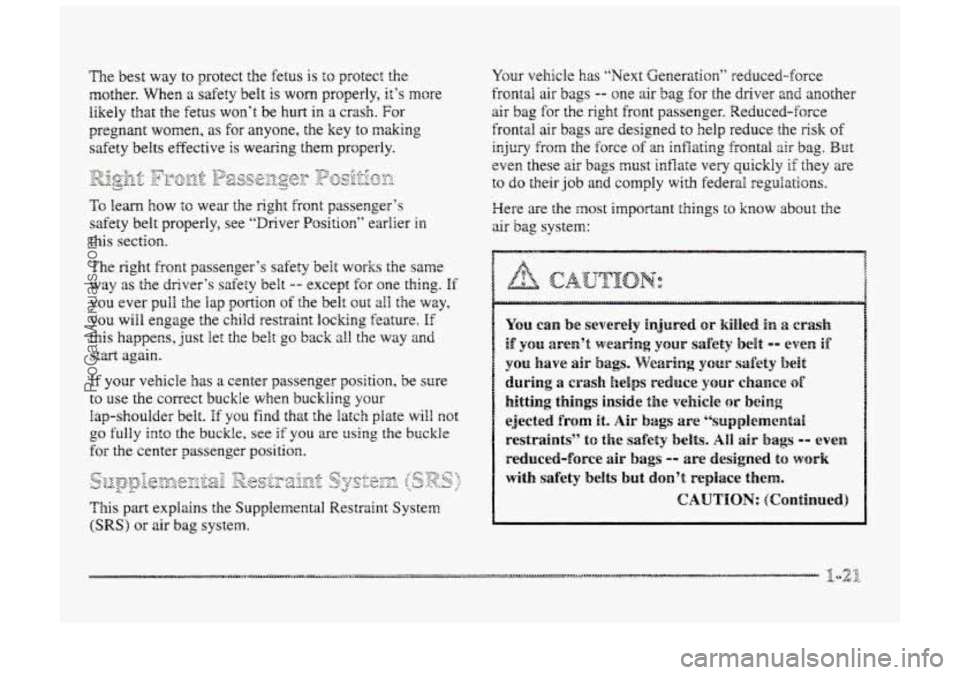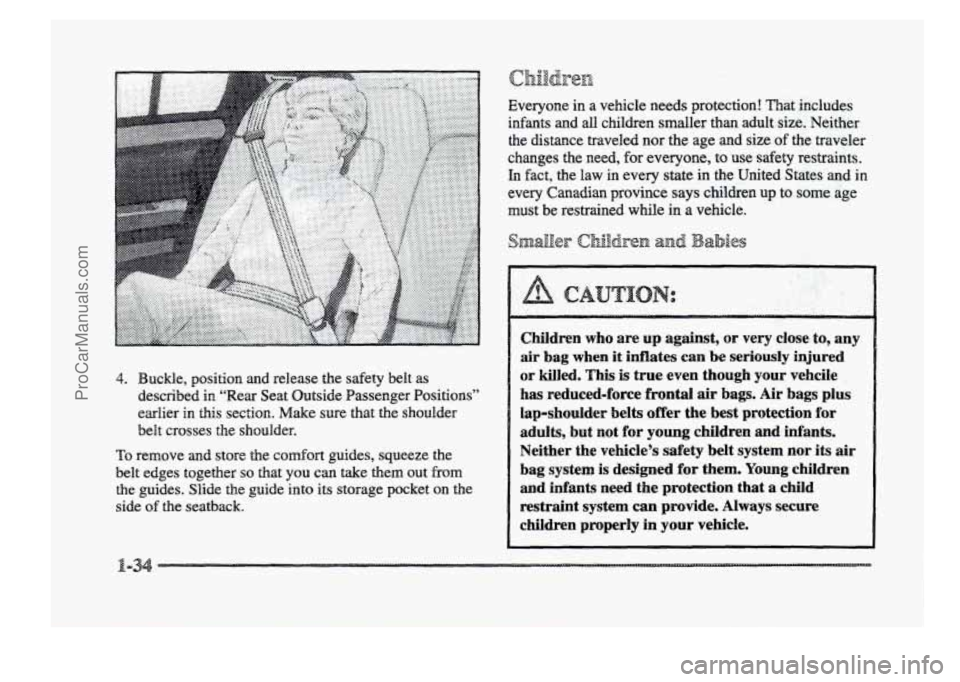Page 13 of 426
Here you'll find information about the seats in ycur Buick and how to use your safety belts propedy. You can also
learn about some things you should not do with air bags and safety belts.
1-2
1-8
1-12
1-13
1-13
1-20
1-21
1-28
B -27 Seats
and Seat Controls
Safety
Belts: They're for Everyone
Were
Are Questions Many Teogle Ask
About Safety Belts -- and the Answers
How to Wear Safety Belts Properly
Driver Position
Safety Beit Use During Pregnancy
Right
Front Passenger Position
Supplenental Restraint System
(SRS)
Center Passenger Position
1-28
1-32
1-34
1-37
1-47
9 -50
i -50
1-50
Rear Seat Passengers
Rear Safety Belt
CSITI€OI-~ Guides for
Children
and Small Adults
Children
Child Restraints
Larger Children
Safety Belt Extender
Checking Your
Restraint Systems
Replacing Restraint System
Parts After
a Crash
ProCarManuals.com
Page 33 of 426

The best way to protect the fetus is to protect the
mother.
When a safety belt is worn properly, it’s more
likely that
the fetus won’t be hurt in a crash. For
pregnane women,
as for anyone, the key to making
safety belts effective
is wearing them properly.
To Bern how io wear the right front passenger’s
safety belt properly, see “Driver
Po~itiod’ earlier in
this section.
The right
front passenger’s safety beit works the same
way as the driver’s safety belt -- except for one thing. If
you ever pull the lap p~rtio~~ of the belt out all the way,
you will engage the child restraint locking feature. If
this happens, just let the belt go back all the way and
stat again.
hf your vehicle has a center passenger position, be sure
to use the correct buckie when buckhg your
fap-shoulder belt.
If you find that the latch plate will not
go fully irrto the buckle, see if you are using the buckle
for the center passenger position.
This part explains the Supplemental Restraint System
(SRS) or ais bag system. Your vehicle
has “Next Generation” reduced-force
frontal air bags -- one air bag ~QI“ Fhe driver 2nd another
air bag
for the right front passenger. Reduced-force
frontal
air bags are designed to help seduce the risk of
injury from the force of an inflating frontal air bag. Bst
even these air bags xmst inflate very quickly if they ae
to do their job and comply with federal regulations.
Here are the most important things to know about the
air bag system:
ProCarManuals.com
Page 35 of 426
CAmHoN: (CQdIIUd)
Young children and infants need the protection that
a child restraint system can provide. Always
secure children properly in your vehicle.
To
read how, see the part of this manual called
“Children”
and see the caution labels on the
smvisoss and the right front passenger’s
safety belt.
There is an air bag
readiness light
on the
instrument panel, which
BAG
shows AIR BAG.
The system checks the air bag electrical system for
malfunctions. The light
tells YOU if there is an electrical
problem. See
“Air Bag Readiness Light” in the Index
for more information.
..
... ... .; ........
Where are the air bags?
The driver’s air bag is in the middle of the
steering wheel.
ProCarManuals.com
Page 44 of 426
Rear shoulder belt c~mfort guides will provide added
safety belt COXII~QI-~ for children who have outgrown
child restraints
and for small adults. Men installed on a
shoulder belt, the codort guide pulls the belt away
from the neck and head.
There
is one guide for each outside passenger position in
the rear seat. TO provide added safety belt comfort for
children
who have outgrown child restraints ad for
smaller adults, the COIII~Q~~ guides may be installed on
the shoulder belts. Here's how to install a comfort guide
and use the safety belt:
1. Remove the guide from its storage pocket QIZ the side
of the seatback.
ProCarManuals.com
Page 46 of 426

4. Buckle, position and release the safety belt as
described
in “Rear Seat Outside Passenger Positions”
earlier
in this section. Make sure that the shoulder
belt crosses the shoulder.
To remove and store the comfort guides, squeeze the
belt edges together so that you can take them out from
the guides. Slide the guide into its storage pocket on the
side
of the seatback.
Children
Everyone in a vehicle needs protection! That includes
infants and all children smaller
than adult size. Neither
the distance traveled nor the age and size of the traveler
changes the need,
for everyone, to use safety restraints.
In fact, the law in every state in the United States and in
every Canadian province says children up to some age
must be restrained while in
a vehicle.
Children who are up against, or very close to, any
air bag when it Mates can be seriously injured
or Wed.
This is true even though your vehcile
has reduced-force frontal air bags. Air bags plus
lag-shoulder belts offer the best protection for
adults, but not for young children
and infants.
Neither the vehicle’s safety belt system nor its air
bag system is designed for them. Young children
and
infants need the protection that a child
restraint system can
provide. Always secure
children
properly in your vehicle.
ProCarManuals.com
Page 47 of 426
Smaller children and babies should always be
restrained in
a child or infant restraint. The
instructions
for the restraint will say whether
it is the right type and size for your child. A
very young child’s hip bones are so small that a
~ seguiar belt might not stay low on the hips, as it
I should. Instead, the belt will likely be over the
I child’s abdomen. In a crash, the belt would apply
’ f~~e right on the child’s abdomen, which could
~ cause serious or fatal injuries. So, be sure that
1 any child small enough for one is always properly
j restrained in a child or infant restraint.
I
ProCarManuals.com
Page 49 of 426
A: Add-on child restraints are available in four
basic types. When selecting a child restraint,
take int~ consideration not only the child’s weight
and size, but dso whether or not the restraint will
be compatible with the motor vehicle in which it
will be used.
An infant car bed (A) is a specid bed made for use
in a motor vehicle. It’s an infant restraint system
designed
to restrain or position a child on a
continuous flat surface. With an idat car bed,
make sure that the infant’s head rests toward the
center of the vehicle.
ProCarManuals.com
Page 53 of 426
Wnen choosing a child restraint, be sure the child
restraint is designed to be used in
a vehicle. If it is, it
will have
a label saying that it meets Federal Motor
Vehicle Safety
Standards.
Ynen foliow the instructions for the restraint. You may
fixi these instructions on the restraint itself or in a
booklet, or both. These restraints use the belt system in
your vehicle, but the child also has to be secured within
the restraint to help reduce the chance of personal. injury.
The insmctions that come with
the infant or child
restraint will show YOU how to do that. Both the owner's
manual and the chiid restraint instructions are important,
so if either one of these is not available, obtain a
replacement copy from the manufacturer.
ProCarManuals.com